
TNU Journal of Science and Technology
229(14): 35 - 42
http://jst.tnu.edu.vn 35 Email: jst@tnu.edu.vn
q-DIFFERENCE ANALOGUE OF THE LEMMA ON THE LOGARITHMIC
DERIVATIVE AND SOME APPLICATIONS
Pham Thi Thuy*, Trinh Thi Diep Linh
TNU - University of Education
ARTICLE INFO
ABSTRACT
Received:
09/7/2024
Recently, Nevanlinna theory applied to study difference-differential
equations, also value distribution of difference-differential
polynomials. This research direction has attracted the attention of many
mathematicians in the country as well as around the world. In this
paper, by using q-difference analogue of the lemma on the logarithmic
derivative and Nevanlinna theory for meromorphic functions in several
variables, we study the proximity function of solutions to q-shift
difference-partial differential. Our results show that under some
suitable conditions of degree of equations, proximity function of
solutions is small function in comparing with characteristic functions.
In addition, we establish a new lemma on the counting function of
zeros of the partial derivative of meromorphic function in several
variables, and apply that result to study the value distribution of
difference-partial differential polynomials. In our best knowledge, our
results are new and some future works can be done by using our
previous results.
Revised:
07/10/2024
Published:
08/10/2024
KEYWORDS
Meromorphic functions in
several variables
Nevanlinna theory
q-shift difference - partial
differential equations
Value distribution of difference
polynomials
Small functions
BỔ ĐỀ q-SAI PHÂN TƯƠNG TỰ CỦA BỔ ĐỀ ĐẠO HÀM LOGARIT
VÀ MỘT SỐ ỨNG DỤNG
Phạm Thị Thủy*, Trịnh Thị Diệp Linh
Trường Đại học Sư phạm - ĐH Thái Nguyên
THÔNG TIN BÀI BÁO
TÓM TẮT
Ngày nhận bài:
09/7/2024
Thời gian gần đây, Lý thuyết Nevanlinna đã được ứng dụng trong
nghiên cứu phương trình vi-sai phân, cũng như phân bố giá trị của đa
thức đạo hàm-sai phân. Hướng nghiên cứu này đã thu hút được sự quan
tâm của nhiều nhà toán học trong và ngoài nước. Trong bài báo này, sử
dụng Bổ đề q-sai phân tương tự đạo hàm logarit và Lý thuyết
Nevanlinna cho hàm phân hình nhiều biến, chúng tôi nghiên cứu hàm
xấp xỉ cho nghiệm của phương trình q-dịch chuyển sai phân-đạo hàm
riêng. Kết quả của chúng tôi chỉ ra rằng với một số điều kiện về bậc của
phương trình, hàm xấp xỉ của nghiệm là nhỏ so với hàm đặc trưng.
Ngoài ra, bằng việc thiết lập một bổ đề mới về hàm đếm các không
điểm của đạo hàm riêng của hàm phân hình nhiều biến, chúng tôi ứng
dụng kết quả đó vào nghiên cứu phân bố giá trị của đa thức sai phân-
đạo hàm riêng. Theo hiểu biết tốt nhất của chúng tôi, các kết quả trong
bài báo là mới và một số nghiên cứu trong tương lai có thể được hoàn
thiện bằng việc sử dụng kết quả trước đó của chúng tôi.
Ngày hoàn thiện:
07/10/2024
Ngày đăng:
08/10/2024
TỪ KHÓA
Hàm phân hình nhiều biến
Lý thuyết Nevanlinna
Phương trình q-sai phân-dịch
chuyển đạo hàm riêng
Phân bố giá trị của đa thức sai
phân
Hàm nhỏ
DOI: https://doi.org/10.34238/tnu-jst.10735
* Corresponding author. Email: thuypt.exc@tnue.edu.vn

TNU Journal of Science and Technology
229(14): 35 - 42
http://jst.tnu.edu.vn 36 Email: jst@tnu.edu.vn
1. Introduction
First, we remind some notations and definitions in Nevanlinna theory for meromorphic
functions in several variables. Set
22
1
| | | |
m
j
j
zz
for all
1
( ,..., ) ,
m
m
z z z
( ) { : | | },
m
m
S r z z r
1
( ) { : | | }, , ( ),
4
m c
m
B r z z r d d
2 2 1 2
log | | , log | | ( ), ( ) | | .
c c m c
m m m m
dd z d z z z dd z
Let
be divisor
in
.
m
Set
supp { : ( ) 0}.zz
We define the counting function of
by
21
1
()
( ) ,1 ,
r
m
nt
N r dt r
t
where
1
supp ( )
()
m
m
m
Bt
nt
, for
2m
, and
||
( ) ,
zt
nt
for
1.m
Let
F
be a nonzero holomorphic function on
m
. For a set
1
( , , )
m
of
nonnegative integers, we set
1
| |: m
and
1
||
||
1
:.
m
m
DF zz
We define the
zero divisor
F
of
F
by
||
max{ : ( ) 0 for all :| | }.
Fp D F z p
Let
be a nonzero
meromorphic function on
.
m
For each
0
m
z
, the zero divisor
of
is defined as follows:
we choose nonzero holomorphic functions
F
and
G
on a neighborhood
U
of
0
z
such that
F
G
on
U
and
11
dim( (0) (0)) 2F G m
, then we put
.
F
For each
1()a
wih
1( ) , m
a
the couting function of
a
-point of
is definied as following. We denote
()a
by the
a
-divisor of
.
This means, if
01
( : )
is a expression reducing of
.
Then
the
a
-divisor
()a
is the divisor associated with the holomorphic functions
10
.a
Thus
10
( ) ( ).
m
a
z
az
We define
1
supp ( ) ( )
( , ) ( )
m
m
m
a B r
n r a a
outside a set analysis
with codimension 2, i.e
11
1 0 0
dim(( ) (0) (0)) 2,am
for all
1m
and
0,r
where
supp ( )a
denotes the closure of the set
{ : ( )( ) 0}. m
z a z
The counting function
( , )N r a
(or
1
( , ))Nr a
of
a
-point of
is defined by
21
1
( , )
( , ) .
r
m
n t a
N r a dt
t
For a positive integer
M
, we define
( ( 1
supp ( ) ( )
( , ) ( )
m
M M m
m
a B r
n r a a
outside a set
analysis with codimension 2, i.e
11
1 0 0
dim(( ) (0) (0)) 2,am
where
(( ) 0
Ma
if
()aM
and
(( ) 1
Ma
if
( ) .aM
The reduced counting function
(( , )
M
N r a
(or
(1
( , ))
M
Nr a
of
a
-point of
with multiplicities not less than
M
is defined by
(
(
21
1
( , )
( , ) .
M
r
M
m
n t a
N r a dt
t
Let
k
be a positive integer and
,a
we set

TNU Journal of Science and Technology
229(14): 35 - 42
http://jst.tnu.edu.vn 37 Email: jst@tnu.edu.vn
(2 (
1
( , ) ( , ) ( , ) ( , ).
k
k
N r N r a N r a N r a
a
The proximity function of
is defined by
()
()
1
log ( ),
| ( ) |
( , ) .
log | ( ) | ( ),
m
m
m
Sr
m
Sr
za
za
m r a
z z a
The characteristic function of
is defined by
( , ) ( , ) ( , ).T r m r N r
The order and
hyperorder of
are respectively defined by
log ( , )
( ) sup l
io
lg
m
r
Tr
r
and
log log ( , )
( ) sup .
lg
lim o
r
Tr
r
We also denote by
1
( , ) ( , ) ( , ),T r m r a N r a
a
where
.a
Some time, we also denote
( , )T r a
by
1
( , )Tr a
,
( , )m r a
by
1
( , )mr a
and
( , )Nr
by
( , ).Nr
First Main Theorem gives that
1
( , ) ( ) (1).T r T r O
a
The
q
-shift difference-partial differential polynomial of meromorphic function
f
on
m
is
defined by
1
||
,
101
( , ) ( ) ( ( )) ,()
j
ij
j jm
I
p
NS
ill
ijm
f
P z f z T z
zz
jj
qc
where
,( ) ,
jj
T z z
jj
qc qc
(1 ,0 )
ij
S i N j p
,
jt
l
,
1tm
are nonnegative
integers,
,MN
are positive integers,
1
( , , ) ,
m
j j jm
I l l
1
0 | |
m
j jt
t
I l M
,
m
jc
,
0, ,jp
,
1 ( , , ) {0,1}
j j jm
m
qq q
means that
{0,1}, 1, ,
ji
q i m
, and
(1 )
iiN
are small (with respect to
f
) meromorphic functions. The degree
()DP
of
f
is
defined by
1
0
( ) max { }.
p
i N ij
j
D P S
We also denote lower degree of
P
by
1
0
( ) min { }.
p
i N ij
j
d P S
In complex plane, Yang and Laine [1], [2] established some Clunie-type results for difference
or
q
-difference polynomial of meromorphic functions. In 2010, Huang and Chen [3] extended
the result of Yang and Laine [1] for q-difference polynomial with many terms of maximal total
degree. Cao and Xu [4] gave a difference analogue of Clunie-type lemma for meromorphic
functions on
m
with hyperorder less than 1. In [5], Luong, Nguyen and Pham established a q-
difference analogue of the lemma on the logarithmic derivative and apply it to study the value
distribution of holomorphic curves. Cao and Korhonen [6] prove a
q
-difference analogue of the
lemma on the logarithmic derivative and using that result, they obtained some q-difference
counterpart of Clunie-type results. Hu and Yang [7] and Hao and Zhang [8] extended the
Clunie’s lemma for meromorphic function in several variables. Motivated by that results, we first
prove a Clunie-type result in
m
as follows:

TNU Journal of Science and Technology
229(14): 35 - 42
http://jst.tnu.edu.vn 38 Email: jst@tnu.edu.vn
Theorem 1. Let
1
: ( )
m
f
be a transcendental meromorphic with order zero such that
(0) 0, .f
Assume that
f
is solution in
m
of equation
( ) ( , ) ( , ),
n
f z P z f Q z f
where
( , )P z f
,
( , )Q z f
are
q
-shift difference-partial differential polynomial of meromorphic
function
,f
and the degree
()DQ
of
( , )Q z f
satisfying
()D Q n
, then we have the following
estimate
( , ) ( , ) ( , ).
P z f
m r S r f
Similarly Theorem 1, we have the result as follows.
Theorem 2. Let
1
: ( )
m
f
be a transcendental meromorphic with order zero such that
(0) 0, .f
If
f
is solution in
m
of equation
( ) ( , ),
n
f z P z f
where
( , )P z f
is
q
-
shift difference-partial differential polynomial of meromorphic function
,f
and the lower degree
()dP
of
P
satisfying
0 ( )n d P
, then
( ,0) ( , ).
f
m r S r f
In [9], Xu and Zhong study the value distributions of q-shift difference polynomial
( ) ( )
n
f qz af z
of a meromorphic function
f
in complex plane. We denote by
1
1
1
( , , ) ,
m
k
k
ml
l
m
f
D f z z zz
where
1
( , , ) m
m
ll
and
1.
m
l l k
Motivate by the
work of Xu and Zhong [9], we establish a result on value distribution of
q
-shift difference-
partial differential polynomial as follows:
Theorem 3. Let
f
be transcendental meromorphic function on
m
with order zero such
that
(0) 0, ,f
and
{0,1},
m
q
{0}.
m
c
Let
,nk
be two positive integers with
24nk
. Then
( )( )( ) ( )
nk
f z D f z a zqc
has infinitely zeros, where
( ) 0az
is a small
function of
.f
Remark. If
(1,...,1) ,
m
q
then our theorems still hold for meromorphic functions in
several variables with hyperorder less than 1 via Lemma 3 and Lemma 4 which contained in [10].
2. Preliminary
Lemma 1 [5]. Let
f
be a meromorphic function in
m
of zero order such that
(0) 0,f
and let
1
( , , ) {0,1}.
m
m
qq q
Then
()
( , ) ( ( , ))
()
fz
m r o T r f
fz
q
on a set with
logarithmic density 1.
Lemma 2 [5]. Let
f
be a meromorphic function in
m
of zero order such that
(0) 0, ,f
and let
1
( , , ) {0,1} m
m
qq q
. Then
( , ( )) ( , ) ( , )T r f z T r f S r fq
a set with
logarithmic density 1.Lemma 3 [10]. Let
f
be a non-constant meromorphic function in
m
such that
(0) 0,f
, let
.
m
c
If
( ) 1,f
then
()
( , ) ( , ),
()
fz
m r S r f
fz
c
for all
0r
outside of a possible exceptional set
[1, )E
of finite logarithmic measure
( ) .
E
dt
lm E t

TNU Journal of Science and Technology
229(14): 35 - 42
http://jst.tnu.edu.vn 39 Email: jst@tnu.edu.vn
Note that logarithmic densities of
[1, )E
is defined by
()
logdense(E)=lim ,
log
r
lm E
r
then any set with finite logarithmic measure has logarithmic densities zero, and its complement
has logarithmic densities 1.
Lemma 4 [10]. Let
1
: ( )
m
f
be a meromorphic function, let
.
m
c
If
( ) 1,f
then
( , ( )) ( , ) ( ( , )),T r f z T r f o T r f c
where
r
outside of an
exceptional set of finite logarithmic measure.
Combine Lemma 1 - Lemma 3, we get the result as follows:
Lemma 5. Let
f
be a meromorphic function in
m
of zero order such that
(0) 0,f
and
let
1
( , , ) {0,1}, .
mm
m
qq qc
Then
()
( , ) ( ( , ))
()
fz
m r o T r f
fz
qc
on a set with
logarithmic density 1, and
( , ( )) ( , ) ( ( , )),T r f z T r f o T r f qc
where
r
outside of an
exceptional set of finite logarithmic measure.
Lemma 6. Let
f
be non-constant meromorphic function on
m
such that
0,
k
Df
then
we have
1
11
( , ) ( , ) ( , ) ( , );
11
( , ) ( , ) ( , ) ( , ).
k
k
k
N r N r kN r f S r f
D f f
N r N r kN r f S r f
D f f
Proof. From Logarithmic Derivative lemma and First main theorem, we get
1 1 1 1 1
( , ) ( , ) ( , ) ( , . ) ( , )
1 1 1 1
( , ) ( , ) ( , ) ( , ) ( , ) ( , )
1 1 1
( , ) ( , ) ( , ) ( , )
11
( , ) ( , ) ( , ) ( , ).
k
k
k
kk
kk
k
k
Df
T r m r N r m r N r
f f f f D f f
Df
m r m r N r m r N r S r f
f D f f D f f
T r N r N r S r f
D f D f f
T r D f N r N r S r f
D f f
From a result of Hu and Yang in [11], we have
( , ) ( 1) ( , ).
k
N r D f k N r f
This implies
11
( , ) ( , ) ( , ) ( , ) ( , )
1
( , ) ( , ) ( , ) ( , ) ( , ).
k
k
kk
N r N r T r D f T r f S r f
D f f
m r D f N r D f T r f N r S r f
f
So we have
11
( , ) ( , ) ( , ) ( , ). (1)
k
N r N r kN r f S r f
D f f
From (1), get
(
2
1 1 1 1
( , ) ( , ) ( , ) ( , ) ( , ) ( , ).
p
k k k
p
N r N r N r N r kN r f S r f
D f D f D f f
Therefore, we get
(
2
1 1 1
( , ) ( , ) ( ( , ) ( , )) ( , ). (2)
p
kk
p
N r kN r f N r N r S r f
D f f D f

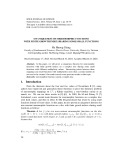
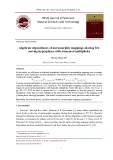
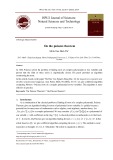
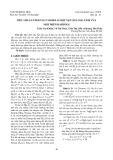
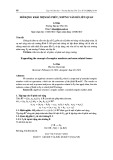
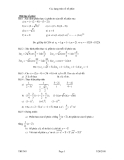

![Mã hóa mức vật lý: Phần [Thông tin chi tiết/Hướng dẫn/Tổng quan]](https://cdn.tailieu.vn/images/document/thumbnail/2011/20110425/magiethitham/135x160/kythuattruyensolieu_pdf0118_0701.jpg)
















![Quyển ghi Xác suất và Thống kê [chuẩn nhất]](https://cdn.tailieu.vn/images/document/thumbnail/2025/20251030/anh26012006/135x160/68811762164229.jpg)
